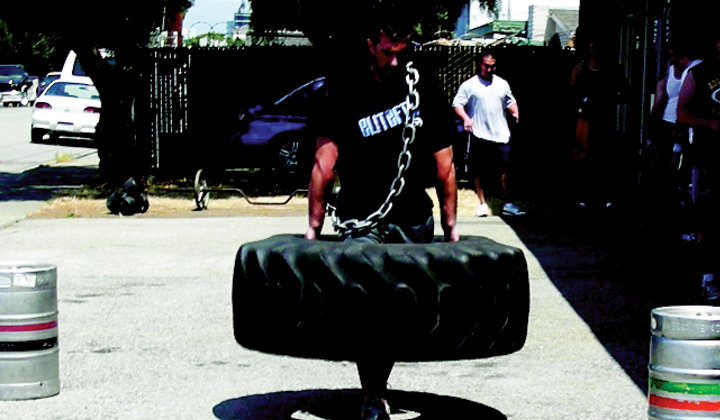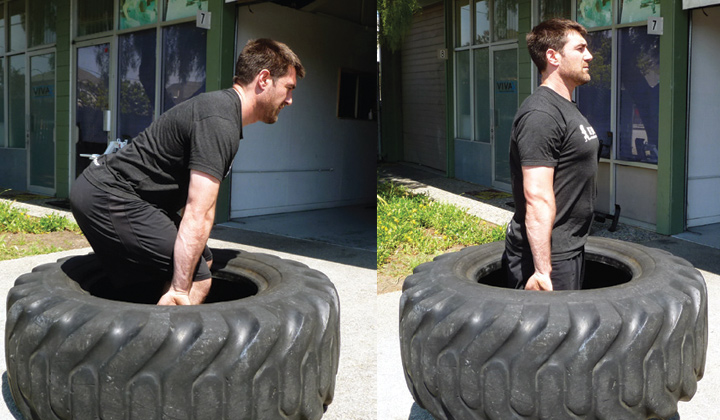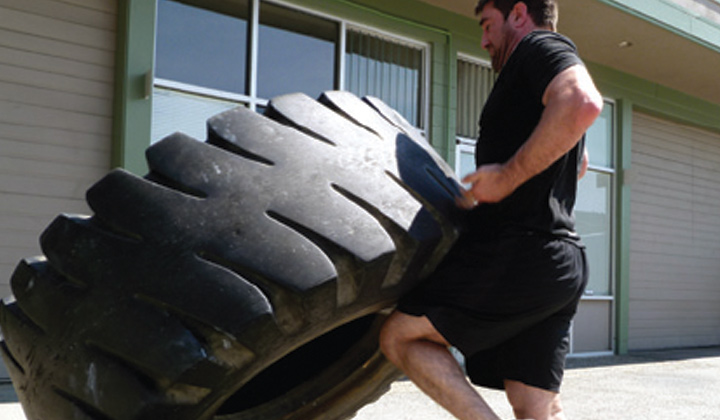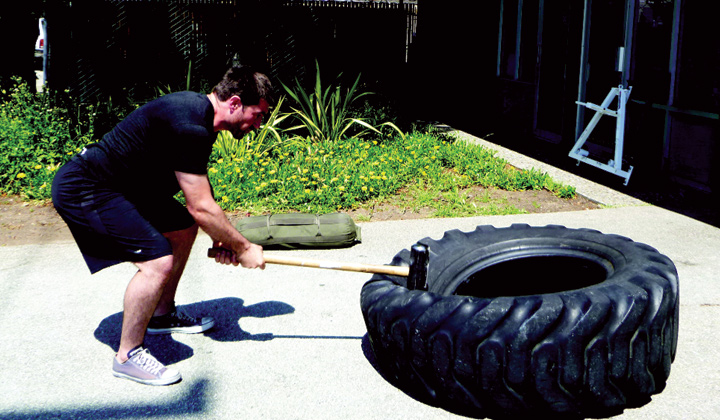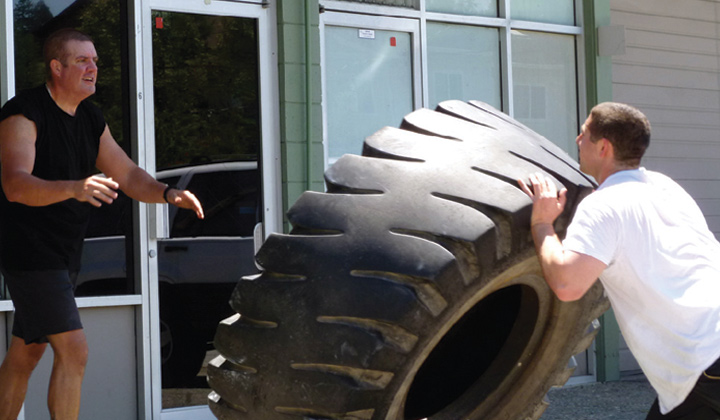Plyometrics
Speed and strength are integral components of fitness found in varying degrees in virtually all athletic movements. Simply put the combination of speed and strength is power. For many years, coaches and athletes have sought to improve power in order to enhance performance. Throughout this century and no doubt long before, jumping, bounding and hopping exercises have been used in various ways to enhance athletic performance. In recent years, this distinct method of training for power or explosiveness has been termed plyometrics. Plyometrics is based on the understanding that a concentric muscular contraction is much stronger if it immediately follows an eccentric contraction of the same muscle.
Plyometric Phases
A plyometric exercise comprises of three phases:
- Eccentric phase, or landing phase, involves the pre-loading (energy is stored) of the agonist muscle group
- Amortization phase, or transition phase, is the time between the concentric and eccentric phases. This time needs to be as short as possible otherwise the energy stored during the eccentric phase dissipates, reducing the plyometric effect
- Concentric phase, or take-off phase, uses the stored energy to increase the force of the movement
Muscle Mechanism
The maximum force that a muscle can develop is attained during a rapid eccentric contraction. However, it should be realised that muscles seldom perform one type of contraction in isolation during athletic movements. When a concentric contraction occurs (muscle shortens) immediately following an eccentric contraction (muscle lengthens) then the force generated can be dramatically increased.
If a muscle is stretched, much of the energy required to stretch it is lost as heat, but some of this energy can be stored by the elastic components of the muscle. This stored energy is available to the muscle only during a subsequent contraction. It is important to realise that this energy boost is lost if the eccentric contraction is not followed immediately by a concentric contraction. To express this greater force the muscle must contract within the shortest time possible. This whole process is frequently called the stretch shortening cycle and is the underlying mechanism of plyometric training.
Choose the method to fit the sport
The golden rule of any conditioning program is specificity. This means that the movement you perform in training should match, as closely as possible, the movements encountered during competition. If you are rugby player, practicing for the line out or a volleyball player interested in increasing vertical jump height, then drop jumping or box jumping may be the right exercise. However if you are a javelin thrower aiming for a more explosive launch, then upper body plyometrics is far more appropriate.
The Klatt Tests
Before starting a programme of plyometrics it is worth conducting the Klatt tests with the athlete. The tests include the basic plyometric movements, so if they cannot be achieved it can be assumed the athlete is not ready for a programme of plyometrics.
Plyometric Exercises
The following are examples of lower body and upper body plyometric exercises.
Lower Body
Drop Jumping
This exercise involves the athlete dropping (not jumping) to the ground from a raised platform or box, and then immediately jumping up. The drop down gives the pre-stretch to the leg muscles (eccentric phase) and the vigorous drive upwards the secondary concentric contraction phase. The exercise will be more effective the shorter the time the feet are in contact with the ground. The loading in this exercise is governed by the height of the drop that should be in the region of 30 to 110 cm (Bompa et.al, 2005)[2]. Drop jumping is a relatively high impact form of plyometric training and would normally be introduced after the athlete had become accustomed to lower impact alternatives, such as two-footed jumping on the spot.
The two key factors in drop jumping are a minimal contact time with the ground and the height achieved in the drive upwards. Schmidtbleicher (1992)[3] says that a ground contact time of <0.25 seconds indicates a fast stretch-shortening cycle (SSC) and to adjust the drop height to achieve this contact time. If contact mats are not available to measure the contact time then observe the athlete's feet. On landing the athlete should stay on the balls of the feet (mid-foot). If the heels come into contact with the ground then the drop height needs to be reduced. Start at a drop height of 30cm and increment the drop height in 15cm steps.
The Reactive Strength Index (RSI) was devised to measure the interaction of the contact time and height jumped in order to monitor the development of explosive power. RSI is calculated by dividing the height jumped (metres) by the contact time (seconds).
Comyns (2012)[4] recommends the key coaching points for the drop jump are:
- Minimise ground contact time - imagine the ground is a hot surface
- Keep your legs stiff on landing
- Minimise the flexion at the knee and hip on landing
- Land on the mid-foot under your hips
- Maximise the height you jump - jump as high as possible
Bounding and hurdling
If forward motion is more the name of your game, try some bounding. This is a form of plyometric training, where over sized strides are used in the running action and extra time spent in the air. Two-legged bounds reduce the impact to be endured, but to increase the intensity one legged bounding, or hopping, can be used. Bounding upstairs is a useful way to work on both the vertical and horizontal aspects of the running action. Multiple jumps over a series of obstacles like hurdles are valuable drills for athletes training for sprinting or jumping events.
Examples of lower body plyometric exercises with intensity level:
- Standing based jumps performed on the spot (low intensity) - Tuck Jumps, Split Jumps
- Jumps from standing (low-medium intensity) - Standing long jump, Standing hop, Standing jump for height
- Multiple jumps from standing (medium intensity) - bounds, bunny hops, double footed jumps over low hurdle, double footed jumps up steps
- Multiple jumps with run in (High intensity) - 11 stride run + 2 hops and a jump into sandpit, 2 stride run in + bounds
- Depth jumping (high-very high intensity) - jumps down and up off box (40 to 100cm), bounding up hill
- Eccentric drop and hold drills (high-very high intensity) - hop and hold, bound/hop/bound/hop over 30 metres (athletes stop and hold on each landing before springing into the next move), drop and hold from a height greater than one metre
Examples of lower body plyometric exercises are detailed on the Leg Plyometric page.
Upper Body
A variety of drills can be used to make the upper body more explosive:
Press ups & hand clap: Press-ups with a hand clap in between is a particularly vigorous way to condition the arms and chest. The pre-stretch takes place as the hands arrive back on the ground and the chest sinks, and this is followed quickly by the explosive upwards action. Once again, to get the best training effect keep the time in contact with the ground to a minimum.
Medicine Ball: Another means of increasing upper body strength popular with throwers is to lie on the ground face up. A partner then drops a medicine ball down towards the chest of the athlete, who catches the ball (eccentric phase) and immediately throws it back (concentric phase).
This is another high-intensity exercise and should only be used after some basic conditioning.
| 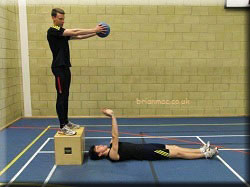 |
Examples of upper body plyometric exercises are detailed on the Arm Plyometric page.
Planning a Plyometric Session
The choice of exercises within a session and their order should be planned. A session could:
- begin with exercises that are fast, explosive and designed for developing elastic strength (low hurdle jumps; low drop jumps)
- work through exercises that develop concentric strength (standing long jump; high hurdle jumps)
- finish with training for eccentric strength (higher drop jumps)
An alternative session could be:
- begin with low hurdle jumps
- progress to bounding and hopping,
- continue with steps or box work
- finish with medicine ball work out for abdominals and upper body
Some examples and explanations of plyometric exercises for the arms and legs are detailed on the Leg Plyometric page and the Arm Plyometric page.
Plyometric drills and their intensity
| Type of exercise | Examples | Intensity |
| Standing based jumps performed on the spot | Tuck Jumps Split Jumps Squat Jumps | Low |
| Forward jumps from standing | Bounds and hops over 10 to 20 metres | Low to Medium |
| Multiple double leg hops from standing | 5 bounds 6 bunny hops Double footed jumps over hurdles Double footed jumps up steps | Medium |
| Multiple single leg jumps from standing start | Single leg hops up stadium steps | High |
| Drop jumps | 2 x 6 jumps for height or distance | High |
| Speed bounds | 4 x 20 metres | High |
| Multiple jumps with run up | 3 x 2 hops and jump into sand pit with a 5 stride approach 2 x 10 bounds with a 5 stride approach | Very High |
Warm up
A thorough warm up is essential prior to plyometric training. Attention should be given to jogging, stretching (dynamic), striding and general mobility especially about the joints involved in the planned plyometric session. A cool down should follow each session.
How many?
It is wise not to perform too many repetitions in any one session and since it is a quality session, with the emphasis on speed rather than endurance, split the work into sets with ample recovery in between. An experienced athlete conducting lower body plyometrics may conduct up to 150-200 contacts in a session - athletes new to plyometric work should start with low to medium intensity exercise with around 40 contacts per session e.g. 2 sets of 6 bunny hops is 12 contacts. Similar approach should be taken with upper body plyometrics.
The focus must always be on quality and not quantity.
Recovery
Allow at least one minute of rest between each exercise repetition so as to allow the neuromuscular system to recover. Allow three days between plyometrics sessions when planning.
Where to do it and what to wear
For bounding exercises use surfaces such as grass or resilient surfaces. Avoid cement floors because there is no cushioning. Choose well-cushioned shoes that are stable and can absorb some of the inevitable impact. All athletes should undergo general orthopaedic screening before engaging in plyometric training. Particular attention should be given to structural or postural problems that are likely to predispose the athlete to injury.
Conditioning for plyometrics
Higher than normal forces are put on the musculo-skeletal system during plyometric exercises so it is important for the athlete to have a good sound base of general strength and endurance. Most experts state that a thorough grounding in weight training is essential before you start plyometrics. It has been suggested that an athlete be able to squat twice their body weight before attempting depth jumps. However, less intensive plyometric exercises can be incorporated into general circuit and weight training during the early stages of training to progressively condition the athlete. Simple plyometric drills such as skipping, hopping and bounding should be introduced first. More demanding exercises such as flying start single-leg hops and depth jumps should be limited to thoroughly conditioned athletes.
Conditioning programs to develop leg strength are detailed on the Lower Leg Conditioning page and the Leg Conditioning page.
Young athletes
Some authors suggest that moderate jumps (low intensity) can be included in the athletic training of very young children (Lohman, 1989)[1]. However, great care needs to be exerted when prescribing any training procedures for preadolescent children. Because of the relatively immature bone structure in preadolescent and adolescent children the very great forces exerted during intensive depth jumps (high intensity) should be avoided (Smith, 1975).
Summary
Plyometric type exercises have been used successfully by many athletes as a method of training to enhance power. In order to realise the potential benefits of plyometric training the stretch-shortening cycle (SSC) must be invoked. This requires careful attention to the technique used during the drill or exercise. The rate of stretch rather than the magnitude of stretch is of primary importance in plyometric training. In addition, the coupling time or ground contact time must be as short as possible. The challenge to you as coach or athlete is to select or create an exercise that is specific to the event and involves the correct muscular action. As long as you remember specificity and to ensure there is a pre-stretch first then the only limit is your imagination.
Plyometric exercise and weight training can be combined in complex training sessions to develop explosive power.
References
- LOHMAN, T.G. (1989): Assessment of body composition in children. Pediatr. Exerc. Sci. 1, p. 19�30.
- BOMPA, T. et al. (2005) Periodisation Training for Sports. 2nd ed. USA: Human Kinetics
- SCHMIDTBLEICHER, D. (1992) Training for power event. In: Komi PV (ed) Strength and power in sport. Blackwell Scientific, London, pp 381-395
- COMYNS, T. (2012) Exploding into action, Athletics Weekly, December 6 2012, p. 58-59www.brianmac.co.uk/plymo.htm










